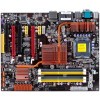- Qualcomm Launches Snapdragon 4 Gen 2 Mobile Platform
- AMD Launches Ryzen PRO 7000 Series Mobile & Desktop Platform
- Intel Launches Sleek Single-Slot Arc Pro A60 Workstation Graphics Card
- NVIDIA Announces Latest Ada Lovelace Additions: GeForce RTX 4060 Ti & RTX 4060
- Maxon Redshift With AMD Radeon GPU Rendering Support Now Available
X48 Roundup: ASUS, ECS & Intel

With so much X48 selection on the market, choosing the right board can be tough. To help make the choice easier, we are taking a look at three such boards all at once, ASUS’ DDR2 Rampage Formula and also the DDR3 ECS X48T-A and Intel’s DX48BT2.
Page 12 – Overclocking & Power Consumption
Between our three motherboards, I expected to be able to present some great overclocking reports, but that’s not so much the case.
ECS X48T-A & Intel DX48BT2
As I mentioned in our look at the ECS board itself, there are features about it that are none-too-impressive. The same applies for the overclocking-ability, sadly. The problem isn’t so much the lack of ability to overclock, but what happens if you somehow fail one.
Many of the top-quality enthusiast motherboards have built-in protections to save you in the event of a failed overclock. Meaning, if you fail an overclock, restoring the PC should be as easy as turning the machine off and waiting a few seconds before turning it back on again. Neither the ECS and Intel board made this task that easy.
On both, failing an overclock immediately results in the requirement of needing to move the small Clr CMOS switch on the motherboard. This is a massive hassle, considering hitting failed overclocks is not exactly a rarity. The ECS board was worse, however, because when you toggle the switch, it resets the entire BIOS. The Intel board, on the other hand, at least retains all settings.
Because the ECS board became a true hassle to overclock, I didn’t even attempt to go far. Even overclocking to 400MHz, which should be stable under all circumstances, didn’t work without a fair amount of effort. It’s just not worth the time.
The Intel board gave me better luck, but I’m not sure luck is what it could be considered. I had that particular board at 400MHz, but after that point, it become a true chore very quickly, leaving me to give up and not bother. It goes without saying, if you take overclocking seriously, neither of these boards are ideal.
ASUS Rampage Formula
While the ECS and Intel boards left a lot to be desire, ASUS’ board saved me from some potential wall-smashing. Like most of the other recent ASUS boards we’ve taken a look at, the Rampage Formula overclocked like a relative dream. The best part of it all was, we never had to increase the NB voltage to unsafe levels, nor the CPU.
With our Core 2 Extreme QX9650, 485MHz was deemed 100% stable. Not ultra-impressive, but we’ve never accomplished higher with this particular chip.

Throwing an E8400 into the machine blew the doors off. At a still-safe 1.65V Northbridge, we pushed the board to 555MHz and still remained entirely stable. This is the first time I’ve hit such a high stable FSB using this or any CPU, so to say I’m impressed would be an understatement.

Between our three boards, it’s apparent which one should be used for overclocking. I had higher hopes for the ECS and Intel, but their design takes all the fun out of pushing your components.
Power Consumption
To capture power consumption, we use a Kill-A-Watt which is plugged directly into the wall, with our PC plugged into it. The monitor and speakers are plugged into a different socket, so our figures here show what our entire PC draw is and nothing else.
Please note that these figures include the Corsair Nautilus 500 water-cooling system, as it feeds off of our computers power. Only one hard drive is plugged in during this testing, and the lone accessory used is a RAM fan. The network adapters are enabled, but no LAN cable is plugged in.
We test grab figures while the machine is idle, and also when the machine is utilizing half of the CPU (QX9650). We then continue to let the 50% CPU usage continue while we load up 3DMark Vantage, to grab a realistic from normal usage. In this case, it would assume playing a game that happens to utilize the CPU well.

Although X48 is still considered to be the enthusiast chipset, the power consumption of the P45 on the ASUS P5Q is fantastic. Whether or not those decreases are thanks to the chipset itself, or the EPU on that board are yet to be seen. We recently received a Gigabyte P45 board, so we’ll have a better idea once we pop it into the machine.
Between the other boards, though, not one comes out on top. All perform quite equally, which is impressive since each one offers a unique set of features onboard. The ECS did wind up being the best X48 on-hand, which isn’t that surprising as the feature-set seems a little barren when compared to the others.
Support our efforts! With ad revenue at an all-time low for written websites, we're relying more than ever on reader support to help us continue putting so much effort into this type of content. You can support us by becoming a Patron, or by using our Amazon shopping affiliate links listed through our articles. Thanks for your support!





